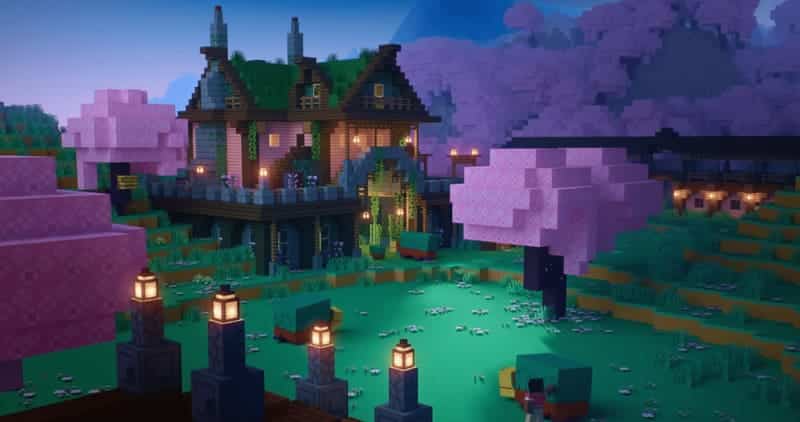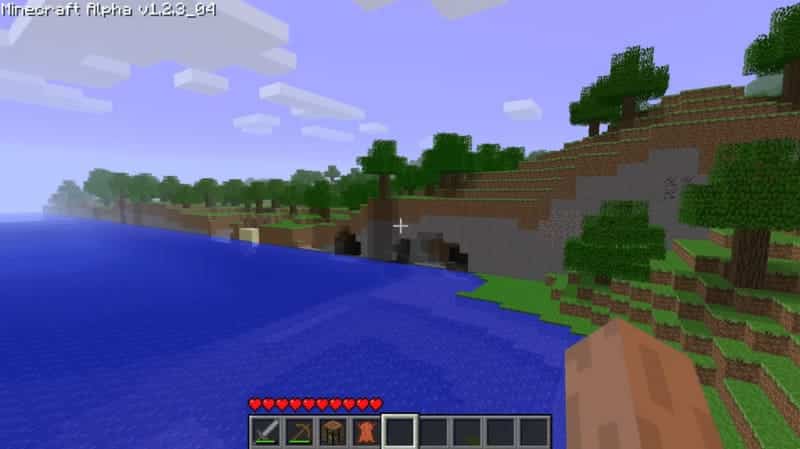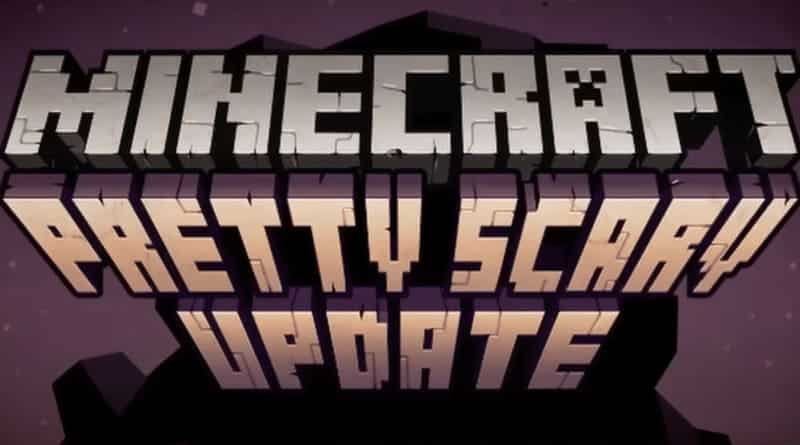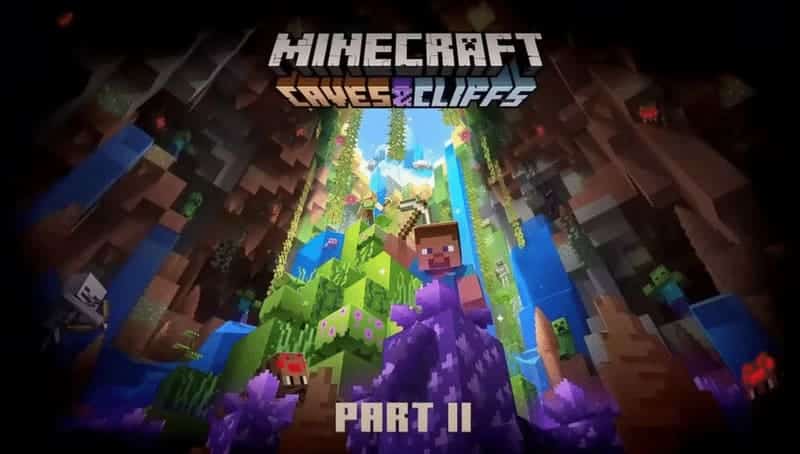Minecraft is a monumental game. It has captivated millions since its debut in 2011. In my opinion, it’s one of the best sandbox games out there, offering endless possibilities. Updates in Minecraft have been critical in keeping the game relevant and engaging. Each update has introduced something new, whether it be mechanics or entirely new places. In this article, I’m going to go over every single Minecraft update. I’ll include the major changes, how those changes have impacted gameplay, and how they have shaped the Minecraft we know today. Let’s jump in!
The Early Days: Classic and Indev
Minecraft’s early development began with a simple but revolutionary concept: a game where players could build and explore in an infinite blocky world. It was created by Markus “Notch” Persson. The first version of the game, known as Classic, was released in May 2009. This initial phase laid the foundation for what would become a gaming phenomenon.
Key Features of Classic
In Classic, Minecraft was purely a creative mode. Players had access to a limited selection of basic blocks, such as dirt, stone, and wood, which could be placed or destroyed to create structures. There were no survival elements or health bars, making it a sandbox for pure creativity. The simplicity of Classic allowed players to experiment with building. This mode emphasized the game’s core principle: providing a blank canvas for limitless imagination.
Introduction of Survival Aspects in Indev
As Minecraft’s popularity grew, the game entered its Indev (In Development) phase in December 2009. This update introduced critical survival aspects that significantly expanded gameplay. Indev brought a finite world with boundaries, where players needed to manage resources, craft items, and survive threats. It introduced essential mechanics like day-night cycles, crafting tables, and basic mobs such as zombies and skeletons. These additions marked a big shift from a creative-only experience to a game that required strategy, resource management, and survival skills.
Alpha Updates: The Foundation of Survival
Minecraft’s Alpha updates were introduced in June 2010. They were some of the most important updates for making the game what we know and love today. This is because these updates introduced several important mechanics and set the stage for its appeal.
Significant Additions: Health, Crafting, and Mobs
One of the most notable features added during this time was the introduction of the health bar. Players now had health that could be depleted by taking damage from environmental hazards or hostile mobs. This brought a new challenge to the game. Crafting is another fundamental gameplay mechanic that was introduced during these updates.
The crafting table was introduced and allowed players to create tools and other items that were needed for survival. Imagine if crafting wasn’t added, it’s weird to picture what the game would be like. Mobs were another critical addition. Hostile creatures like zombies, skeletons, and creepers were added in and spawned at night or in dark areas. They posed threats that players had to fight against.
Multiplayer Introduction
The Alpha updates also introduced the much-anticipated multiplayer mode. This feature allowed players to join servers and collaborate or compete with others in the same world.
Beta Updates: Expanding the World
During its Beta phase, Minecraft experienced some pretty significant expansions that laid the foundation for it to become a fun and immersive sandbox experience. These updates started around December 2010 and marked a time when the game moved beyond its initial boundaries.
Introduction of Biomes and New Terrain Generation
One of the standout achievements of Minecraft’s Beta updates was the introduction of biomes and revamped terrain generation. Prior to these updates, Minecraft worlds were relatively uniform, with limited variation in landscape features. With Beta 1.8, also known as the “Adventure Update,” released in September 2011, Mojang introduced new biomes such as forests, deserts, tundras, and jungles. Each of these biomes introduced new blocks/items and diversified the aesthetic appeal of the game.
Notable Additions: Wolves, the Nether, Weather Systems
Beta updates also introduced iconic features that became integral to Minecraft’s identity. Wolves were added as tamable companions, marking the first instance of non-hostile mobs that players could interact with beyond livestock. The Nether, a whole new dimension, brought new challenges, rewards, and blocks. It was an overall hostile environment and added unique resources like glowstone and netherrack. On top of that, in the overworld, weather systems were introduced. These added atmospheric dynamics that affected gameplay.
Full Release: Minecraft Update 1.0
Minecraft 1.0, was the official release of the game on November 18, 2011, marking the transition from beta phases to a complete, polished experience that set the standard for sandbox gaming.
Introduction of the Ender Dragon
The Ender Dragon, as mentioned earlier, was the ultimate challenge for players and one of the biggest updates for Minecraft at the time. Defeating this boss required planning and an understanding of fighting mechanics. This boss was introduced as an endgame goal.
Stabilization and Performance Improvements
Significant efforts were made to enhance stability and optimize performance in this update since it was a full release, as it should be. Bug fixes, smoother mechanics, and overall gameplay polish ensured a more seamless experience across various platforms.
The Pretty Scary Update: Minecraft Update 1.4
Minecraft 1.4, also known as the “Pretty Scary Update,” released on October 24, 2012, introduced a host of spooky and creative elements that enriched both survival and creative modes.
Introduction of New Mobs
One of the standout features was the introduction of new mobs. Witches, equipped with potions and spells, introduced a new level of difficulty. The Wither, a powerful boss mob, posed quite the challenge requiring preparation and significant combat skills. Bats were also added, while not aggressive can give you quite the jumpscare in caves, adding ambiance to caves, and enhancing immersion.
Addition of Command Blocks
Command blocks were a groundbreaking addition. They allowed players with creative control over their worlds. These blocks allowed for complex automation and manipulation of game mechanics through command inputs. They became a huge part in creating custom maps, adventure scenarios, and complex redstone contraptions.
The Redstone Update: Minecraft Update 1.5
Minecraft 1.5, known as the “Redstone Update,” introduced new Redstone mechanics that revolutionized automation in the game and technical gameplay. It was released on March 13th, 2013.
Introduction of Hoppers
Hoppers were a huge addition that allowed for the automated transfer of items between containers and machines. These versatile blocks facilitated complex item sorting systems, automatic smelting setups, and efficient storage solutions. Hoppers became essential for creating fully automated farms and intricate redstone contraptions. These are a big part of the game today since they make gameplay efficient, especially for technical players.
Droppers and Comparators
Droppers and comparators further improved redstone functionality. Droppers provided a mechanism to dispense items in a controlled manner, essential for creating item elevators, dispensers, and trap systems which many players use today. Comparators enabled players to measure signal strength from various redstone components. This may not seem like much, but it allowed for more precise automation and intricate circuit designs.
The Horse Update: Minecraft Update 1.6
Minecraft 1.6, dubbed the “Horse Update,” released on July 1, 2013, introduced horses, along with several features for horses that expanded gameplay possibilities in various ways.
Introduction of Horses
The Horse Update introduced horses which became a new mode of travel, offering increased speed and agility compared to traditional methods like walking or using minecarts. These mobs added a layer of realism and adventure to the game, as players could now, tame a horse and travel the game’s landscapes more quickly.
New Items: Horse Armor, Leads, and Hay Bales
Along with the introduction of horses new items were added that were essential for interacting with and caring for them:
- Horse Armor: Horse armor provided protection for horses. It came in various materials, such as iron, gold, and diamond. This not only allowed for customization based on players’ preferences but also a level of protection.
- Leads: Leads, often referred to as leashes, allowed players to tether horses to fences or other objects, preventing them from wandering off. This feature was particularly useful when stabling or traveling with them.
- Hay Bales: Hay bales served as food for horses, they allowed you to heal your horse if they were to take any damage. They were also useful for breeding horses.
The Update that Changed the World: Minecraft Update 1.7
Minecraft 1.7, known as the “Update that Changed the World,” introduced big changes. World generation, biome, and block changes were the main part of this update. It completely changed the building and exploration aspects of the game. The update was released on October 25th, 2013.
Changes to World Generation
Minecraft 1.7 transformed world generation by expanding the variety and complexity of biomes. Previously, Minecraft landscapes were mostly uniform, but this update introduced a diverse range of new biomes. Biomes such as the Mega Taiga, Roofed Forest, and Savannah were added, each with unique terrain features. I remember visiting a Mega Taiga for the first time in the game, thinking it was so cool! This diversity not only made exploring the game world more appealing visually but also encouraged players to venture out in search of new landscapes and resources.
Introduction of New Biomes and Blocks
The Update that Changed the World introduced several new biomes that improved the Minecraft environment:
- Mesa Biome: Known for its unique clay blocks and plateaus, the Mesa biome offered quite the contrast to the traditional green landscapes we saw in the game. It provided players with a new terrain to explore and build in.
- Ice Spikes Biome: Featuring towering ice spikes and packed ice, this biome added icy landscapes, inspiring players to create unique structures among the frozen spires.
- Sunflower Plains: Introduced along with actual sunflowers. This biome brought a splash of color to the game, offering a cozy and scenic location for building and decoration.
Alongside these biomes, Minecraft 1.7 also introduced new blocks that complemented the diverse landscapes:
- Podzol: This is a type of dirt found in certain biomes. For example, it can be found in the Mega Taiga and only collected with a silk touch tool. Podzol allowed players to create more varied and natural-looking terrain.
- Stained Glass: Available in a wide variety of colors, stained glass added decorative possibilities to the game, enabling players to make more intricate designs for their build.
Bountiful Update: Minecraft Update 1.8
Minecraft 1.8, also known as the Bountiful Update, brought significant additions that expanded gameplay. This is particularly true about ocean monuments, and new mobs like Guardians and Elder Guardians. It was released on September 2nd, 2014
Addition of Ocean Monuments
One of the standout features of Minecraft 1.8 was the addition of ocean monuments. These underwater structures, made primarily of prismarine blocks, provided players with challenging exploration opportunities. Guarded by the new hostile mob, Guardians, these monuments offer valuable loot such as sponges, prismarine shards, and sea lanterns. Their introduction incentivized players to explore ocean biomes in search of these rare and lucrative structures.
New Mobs: Guardians and Elder Guardians
Minecraft 1.8 introduced two new aquatic mobs: Guardians and Elder Guardians. Guardians are small, hostile fish-like creatures found within ocean monuments, capable of shooting laser beams that inflict significant damage.
Elder Guardians, larger and rarer variants, spawn less frequently within the monuments and possess stronger attacks, adding an extra layer of challenge for players attempting to conquer these underwater dungeons. These mobs not only diversified the marine life in Minecraft but also introduced strategic combat elements, requiring players to adapt their tactics.
Introduction of Slime Blocks and Their Uses
Another notable addition in Minecraft 1.8 was the introduction of slime blocks. Crafted from slime balls obtained by defeating slimes, these blocks have unique properties that revolutionized redstone contraptions and mechanical creations. Slime blocks are known for their ability to bounce entities, which opened up possibilities for creating piston-driven flying machines, automated farms, and elaborate redstone circuits.
Combat Update: Minecraft Update 1.9
Minecraft 1.9, known as the Combat Update introduced big changes to the game’s combat mechanics. The goal was to enhance depth and strategy in battles, particularly in player-versus-player (PvP) scenarios. It was released on February 29th, 2016.
Changes to Combat Mechanics
The Combat Update overhauled the way combat was approached in Minecraft. One of the biggest changes was the introduction of a cooldown for weapons. This meant that after each attack, there was a brief period during which the player’s weapon needed to recharge before it could deal full damage again.
This shifted combat from primarily rapid clicking to a more tactical approach where timing and strategy became important. Players needed to time their attacks strategically to maximize damage output and efficiency in battles.
Introduction of Dual-Wielding and New Combat Techniques
Minecraft 1.9 also introduced dual-wielding. This allows players to hold an item in each hand at the same time. This feature changed and added combat styles, allowing players to wield different combinations of weapons, shields, or items.
For example, players could use a sword in one hand for offense while holding a shield in the other for defense, or dual wield a pickaxe and torches while mining for increased efficiency. New combat techniques were also introduced, such as sweeping attacks with melee weapons that could hit multiple enemies simultaneously.
Exploration Update: Minecraft Update 1.11
Minecraft 1.11, also known as the Exploration Update focused on enriching the exploration aspect of the game by introducing new structures, mobs, and tools that enhanced the adventure and discovery elements. It was released on November 14th, 2016.
Introduction of Woodland Mansions
One of the highlight features of Minecraft 1.11 was the introduction of woodland mansions. These expansive structures added a new layer of exploration and challenge to the game. Woodland mansions are rare, randomly generated buildings found in roofed forest biomes. They feature multiple rooms, corridors, and secret chambers inhabited by the hostile Illagers.
New Mobs: Illagers and Llamas
This update introduced a new hostile mob called Illagers. Illagers include Evokers, Vindicators, and Illusioners, who each have unique abilities and behaviors. They provided quite a challenge to players who want to explore woodland mansions.
Additionally, llamas were introduced as a passive mob in Minecraft 1.11. Llamas are found in savanna and mountain biomes and can be tamed and equipped with carpets for decoration. They serve as pack animals, capable of carrying items and forming caravans when led by a lead.
Addition of Treasure Maps and the Cartography Table
To make exploration and treasure hunting easier, this update introduced treasure maps and the cartography table. Treasure maps can be used by players to find hidden chests buried underground or in shipwrecks. These chests have valuable loot and rare items in them. Cartography tables allow players to clone and make large maps.
World of Color Update: Minecraft Update 1.12
Minecraft 1.12, known as the World of Color Update, released on June 7, 2017, brought a vibrant revolution to the game by expanding color options and enhancing building creativity.
Focus on Color
The World of Color Update had the goal of introducing a wide array of new colors and enhancing existing ones within the game. It aimed to provide players with more creative freedom and options when building, and it did just that!
Introduction of Concrete, Terracotta, and New Dye Mechanics
One of the standout features of Minecraft 1.12 was the addition of concrete and terracotta blocks. Concrete blocks are vibrant solid blocks, while terracotta blocks are intricately patterned and designed. These blocks expanded block options to players. These blocks can be crafted using dye mechanics, which allows for customizing colors more precisely by mixing dyes and applying them to various building materials.
Update Aquatic: Minecraft Update 1.13
Minecraft 1.13, also known as Update Aquatic, released on July 18, 2018, made a significant splash by overhauling ocean environments and introducing a variety of new aquatic features.
Major Changes to Oceans
Update Aquatic was a different update for Minecraft but one that was definitely needed. It transformed its oceans from barren expanses into dynamic and vibrant biomes teeming with life and adventure. It introduced extensive changes to underwater terrain generation. Coral reefs, kelp forests, and underwater caves were integrated into the aquatic world, offering players unique areas to discover, new items to use, and new places to build in.
New Mobs: Dolphins, Turtles, and Drowned
Central to the Aquatic Update were new aquatic mobs that enriched gameplay. Dolphins added a playful touch, guiding players towards treasure and underwater ruins while providing companionship in the vast seas. Turtles, on the other hand, brought a calming presence, nesting on beaches and reminding players of the importance of conservation. The drowned, once zombies transformed into creatures lurking underwater, added danger to sunken ruins and shipwrecks.
Introduction of Underwater Ruins and Shipwrecks
Minecraft 1.13 introduced underwater ruins and shipwrecks as key features of its oceanic overhaul. These structures dot the seabed, offering treasure hunters and explorers the chance to uncover hidden loot and valuable resources. Underwater ruins provide a glimpse into Minecraft’s mysterious past, while shipwrecks are immersive builds that can be hard to navigate. However, they offer rewards that are worth it for those brave enough to enter.
Village & Pillage Update: Minecraft Update 1.14
Minecraft 1.14, the Village & Pillage Update, introduced substantial changes to villages, villagers, and added new challenges with the introduction of pillagers and raids. It was released on April 23, 2019.
Changes to Villages and Villagers
This Village & Pillage update completely changed villages in the game, turning them into busy places with improved aesthetics and functionality. They became more diverse, featuring new architecture and buildings such as libraries, butcher shops, and smithies.
Villagers themselves gained professions, each offering unique items that players could get through trading. The update also improved villagers’ behaviors, making them more interactive with their environment. Villagers now have daily routines, interacting with items that fit their role in the village and can restock their trades.
Introduction of Pillagers and Raids
A significant addition in Minecraft 1.14 was the introduction of pillagers, hostile mobs that roamed beyond the safety of villages to cause havoc. Pillagers can be found in patrols or invading villages, attacking villagers and seeking to destroy the settlement. Raids are events where waves of pillagers, vindicators, and other hostile mobs besiege the village. Players need to defend the village and fight off multiple waves of attackers to successfully win.
New Blocks and Items: Barrels, Smokers, and Campfires
Minecraft 1.14 introduced several new blocks and items that improved gameplay and added versatility to building and survival aspects. Barrels provide additional storage options, working like chests but you’re able to open them even if they’re surrounded by other blocks. Smokers and campfires offer improved cooking, by speeding up the process.
Buzzy Bees Update: Minecraft Update 1.15
In Minecraft 1.15, also known as the Buzzy Bees Update, bees were introduced as a key feature, bringing a new dimension of ecological interaction and resource management to the game. It was released on December 10, 2019
Introduction of Bees
Bees are passive mobs that could be found around beehives in flower-rich biomes such as plains and sunflower plains. They play a role in pollination and honey production within the game’s ecosystem.
Honey-Related Items and Their Uses
The Minecraft update introduced several honey-related items and blocks as well. Honey bottles are crafted from honeycombs which are harvested from bee nests or hives, and they provide a new food source with unique properties.
Consuming honey bottles restores hunger and grants a short burst of saturation, making them valuable for sustaining players during adventures. Honey blocks, on the other hand, have sticky properties that alter movement mechanics. They can be used in redstone contraptions as well as for building.
Impact on Farming and Ecosystem
The addition of bees had a significant impact on farming in Minecraft. Beehives and nests encouraged players to create dedicated bee farms playing a vital role in pollinating crops, accelerating growth rates, and increasing yields in nearby crops.
Nether Update: Minecraft Update 1.16
Minecraft 1.16, also known as the Nether Update, completely changed the Nether dimension. It was transformed into a more diverse yet challenging environment with various new features and content. It was released on June 23rd, 2020.
Major Overhaul
The Nether Update was one of the most significant transformations of the Nether since it was introduced to Minecraft. More updates happened for the nether after this one, but this was the first time big changes were made. This update aimed to provide players with new challenges, resources, and exploration opportunities.
New Biomes: Crimson Forest, Warped Forest, and More
Central to this Minecraft update was the introduction of new biomes within the Nether. The Crimson Forest and Warped Forest biomes added striking visual diversity and unique gameplay elements.
The Crimson Forest introduced red vegetation and towering crimson fungi, while the Warped Forest introduced blue warped fungi and warped roots. These biomes added new appeal but also introduced new types of blocks and vegetation that players could utilize in their builds.
Introduction of Piglins, Hoglins, and Netherite
This Minecraft update introduced several new mobs that significantly changed the dynamics of gameplay as well. Piglins, a pig-like humanoid mob, inhabit bastions and are hostile towards players unless they are wearing gold armor. They trade various items, adding a new dimension of interaction and strategy.
Hoglins are big, aggressive mobs that inhabit the Crimson Forest biome. They provide a formidable challenge for players navigating these new environments and can be a good source of food and resources. Netherite, a new rare material stronger than diamond, was also introduced. It can be forged from ancient debris found deep within the Nether and offers enhanced durability and other beneficial properties for tools and armor.
Caves & Cliffs Part 1 and 2 Updates: Minecraft Updates 1.17-1.18
The Caves & Cliffs Updates was another significant evolution for the game, focusing on improving cave systems and mountain terrain. The first update was released on June 8th, 2021 and the second update was released on November 30th, 2021.
Changes to Caves and Mountains
Minecraft 1.17 and 1.18 introduced substantial improvements to underground cave systems and mountain biomes. These updates were designed to make caves and mountain biomes more diverse. These aspects truly became stunning and more challenging to navigate.
Introduction of New Ores, Mobs, and Terrain Generation
One of the key highlights of the Caves & Cliffs Update was the addition of new ores and resources. Copper was added to craft different blocks and lightning rods. Amethyst geodes are a cool find that allows players access to resources to make tinted glass. Terrain generation received an overhaul as well. Mountains were reimagined to have more dramatic peaks and valleys. Lush and dripstone caves were added to the underground, with unique flora and geological formations for players to discover.
The Wild Update: Minecraft Update 1.19
The Wild Update, Minecraft 1.19, introduced big improvements when it comes to the game’s biomes. It was a big update for players who love to explore. This update was released on June 7th, 2022
Focusing on Wilderness and Biodiversity
The Wild Update focused on expanding Minecraft’s environment and introduced two new biomes: the Mangrove Swamp and the Deep Dark. The Mangrove Swamp added a more swampy biome, in comparison to Minecraft’s original swamp biome, with mangrove trees that have roots coming out of the water.
This biome added depth to the game, offering a new immersive environment and opportunities for resource gathering. In contrast, the Deep Dark biome jumped into the mysterious depths of the underground. It features bioluminescent flora and unique sounds. It’s definitely one of the more unsettling areas of the game.
Introduction of the Warden and New Blocks
Central to this Minecraft update was the introduction of the Warden, an intimidating mob that patrols the Deep Dark biome. The Warden’s unique feature is that it’s sensitive to sound, requiring players to be stealthy or face its powerful attacks.
Additionally, new blocks such as mud and sculk sensors were introduced in Minecraft 1.19. Mud blocks offered a new building material that could be used decoratively or functionally. Sculk sensors, on the other hand, introduced innovative mechanics, reacting to vibrations and sound within the environment. These blocks have expanded the creative possibilities for players in various ways.
Trails & Tales Update: Minecraft Update 1.20
The Trails & Tales Update, Minecraft 1.20, enhanced the game with some unique features that aren’t like anything we’ve seen before. This update added depth with new mobs and archeological items. It was released on June 7th, 2023
Focusing on Trails and Tales
This Minecraft update aimed to expand Minecraft’s narrative potential and provide players with more tools to craft their own stories within the game world. It introduced a blend of practical and thematic elements that encouraged exploration and creativity, catering to both adventure-seekers and builders alike.
Introduction of New Features
- Archaeology: One of the highlights of this update was the addition of archaeology mechanics. Players could now excavate ancient artifacts buried beneath the surface using the new brush.
- Camels: Another significant addition to the game, camels provide a unique mode of transportation in desert biomes and a new adorable creature to tame, offering an alternative to horses.
- Hanging Signs: This update also introduced hanging signs, improving the game’s decorative options. While it may not seem like much, it allows players to add more detail to their builds. These signs can be suspended from ceilings or placed on walls.
Tricky Trials Update: Minecraft Update 1.21
The Tricky Trials Update, Minecraft 1.21, is the new Minecraft update. It was one of the most highly anticipated updates in a while! This update introduces a variety of new puzzles and challenges. It was released recently, on June 13th, 2024.
Overview of Minecraft 1.21 Update
This update focuses on challenging players with intricate trials scattered throughout the game. These trials vary in complexity, ranging from logic puzzles to platforming challenges.
New Challenges and Puzzles Introduced
The Tricky Trials Update introduces a diverse array of challenges that span different aspects of Minecraft gameplay:
- Logic Puzzles: Players will encounter puzzles that require logic and problem-solving skills. Puzzles will vary. For example, some of them may involve handling redstone circuits, understanding patterns, or navigating difficult mazes.
- Platforming Challenges: Platforming challenges test players’ agility and coordination as they navigate different jumps and obstacles. These challenges often require precision and spatial awareness and are throwbacks to parkour maps that used to be extremely popular!
So What’s Next?
From what we’ve seen from all previous updates, Minecraft has changed a lot. Some of the updates were so unexpected that it’s hard to know where the game is going to go in the future. It’s safe to say that the developers will continue to surprise us with amazing content. I’m excited to see what they have in store for us!
For More Great Content
If you liked this, check out our Gaming content here!
Total Apex is an all-encompassing content producer. We provide heavily-detailed articles every day on entertainment, gaming, sports, and so much more! Check out all our great sports content Total Apex Sports. Check us out on X @TotalApexEandG and our other sites: Total Apex Entertainment, Total Apex Gaming, Total Apex Sports Bets, and Total Apex Fantasy Sports. For more articles by Brianna Goulet, click here!





